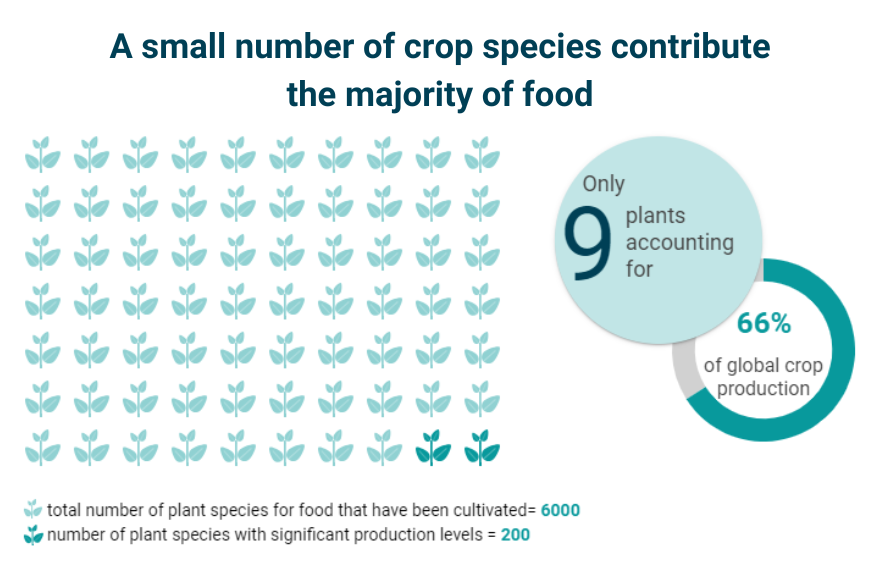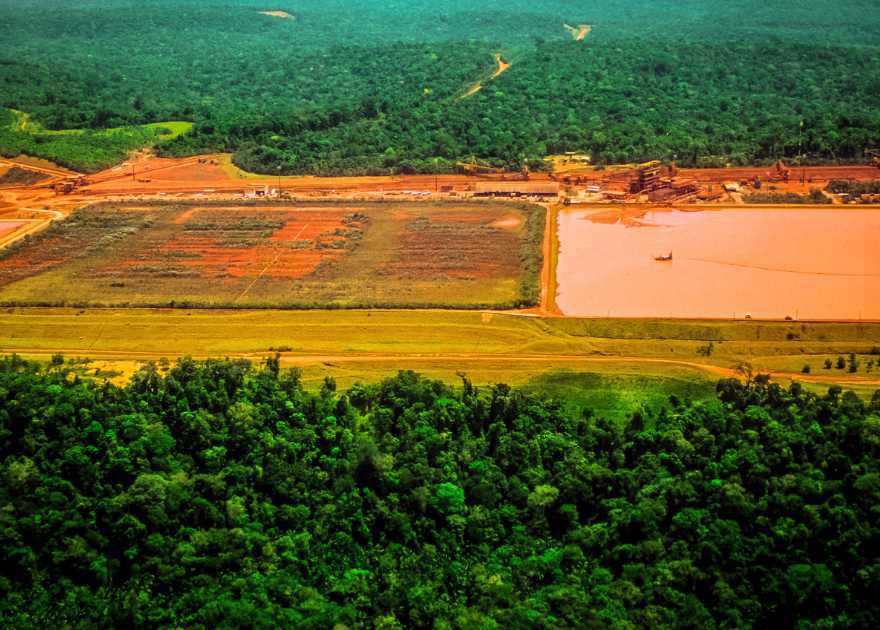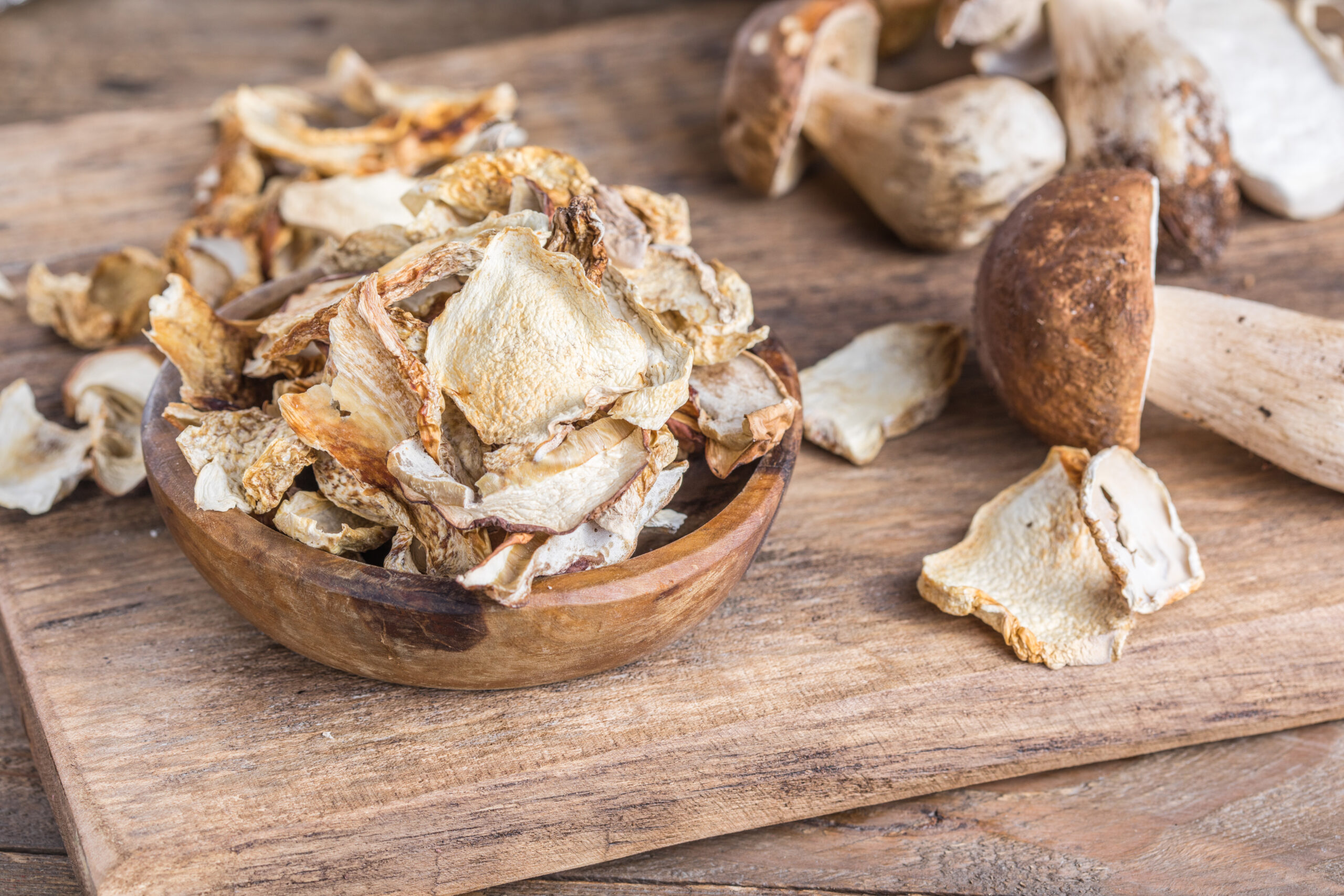In today’s globalized world, food systems have become both a driver of environmental change and a key factor in biodiversity loss. From farming practices to food production and consumption, the ripple effects on ecosystems are profound. The global food system, particularly animal agriculture, is a leading contributor to environmental degradation, deforestation, and biodiversity loss. But food can also be one of the biggest levers to mitigate biodiversity loss and contribute to habitat and species protection. Additionally, diversity isn’t just good for ecosystems – diverse farming practices and a diversity of plant species are needed for food security and to meet nutrition requirements in the future.
What we eat has a massive impact on biodiversity. Agriculture uses half of the earth’s habitable land1 and has drastically changed the face of the planet in the last few decades. Between 2000 and 2018 alone, agriculture was responsible for about 90% of global deforestation2, which results in habitat destruction for countless species. Since the dawn of agriculture more than 10,000 years ago, the planet has lost around a third of its forests, with the rate of loss dramatically increasing during the 20th and 21st centuries3 4. The expansion of agricultural land, particularly for livestock production, directly impacts forests, wetlands, and grasslands. This loss of natural habitats is a primary driver of species extinction.
Agriculture is now listed as a threat to more than 25,000 species5. A Nature study further indicated that, out of 20,000 terrestrial vertebrate species assessed, 88% will lose at least some of their habitat to agricultural expansion by 2050, with 1,300 of them losing more than 25% of their habitats, compared to 2010.6
No biodiversity – no food
Our food systems – and thus global food security – depend on biodiversity and its ecosystem services. These services include soil health and the recycling of nutrients, insect-assisted pollination, and natural pest control for the countless plant species we already eat, as well as for those that might be potential nutrient suppliers in the future.
- Soils are diverse habitats, inhabited by bacteria, fungi, earthworms, and many more organisms — all of which contribute to the health of the land on which we grow our crops.
- About 75% of our food crops depend at least to some extent on pollination by insects and other organisms7. However, populations of pollinators are currently at risk and declining around the world. Some of the main reasons for this decline are habitat loss due to intensive agriculture, the use of pesticides and agrochemicals, the impact of pests and pathogens, pollution by heavy metals, light and sound pollution, and climate change.
- As biodiversity declines, populations of organisms that help with pest control are also disrupted, leading to greater reliance on chemical pesticides (which in turn further disrupts the populations of pollinating and pest-controlling species). A study in Germany reported a 76% decline in airborne insect biomass over 27 years8, reducing both natural pest control and pollination. This is likely to increase costs for farmers and poses risks to the global markets that are reliant on agricultural imports. By diversifying agroecosystems and increasing biological complexity on farms, pest populations can be managed more naturally and sustainably, thus enhancing profitability, safety, and the long-term resilience of our food systems.9
Crop diversity for biodiversity
The global food supply relies heavily on a limited number of staple foods, which has implications for nutrition and food security. Although, historically, more than 6,000 plant species have been cultivated for food, less than 200 currently make substantial contributions to global food production, and just nine plants account for two-thirds of total crop production.10

Biodiversity in agricultural systems benefits both ecosystems and human well-being. Diverse diets that are shaped by regional cultures (and have thus evolved in tandem with the local environment) improve food security by enhancing nutrient supply. Studies show that greater crop diversity is linked to improved dietary diversity and reduced hidden hunger. (Hidden hunger is a form of malnutrition resulting from a lack of essential micronutrients in a person’s diet even though they are consuming enough calories.)11
In addition to species diversity, genetic diversity within crops is crucial for improving yields, resilience, and nutrient content. Wild relatives of cultivated plants, as well as currently underutilized domesticated species, can provide valuable nutrients and contribute to sustainable and resilient food systems.
Farming practices for biodiversity
Sustainable agricultural practices support biodiversity and reduce pressures on habitats and species. Given that monocultures often have negative effects on land use, soil health, and biodiversity, cropping systems that incorporate a variety of plants, agroforestry, and crop rotation can help to restore biodiversity, enhance soil quality, and support beneficial pollinators. By promoting and integrating sustainable agricultural practices, farmers can make their crops more resilient to climate change and other environmental stressors.
In order to protect biodiversity, the following factors are key:
- A transformation of our food system needs to ensure that our diets include a broad diversity of different plants – for increased agricultural biodiversity, enhanced food security and human health, and the long-term resilience of our food systems and global society.
- Farming needs to be nature-friendly and support biodiversity — we need to find ways to transition towards diverse farming practices and cropping systems.
- Reducing our reliance on animal based-foods can potentially free up large amounts of land that could be renaturated and rewilded. This would lead to huge benefits for biodiversity and the planet’s climate system – thus also helping to ensure a more functional and politically stable future for humankind.
By making informed choices at every level – from production to consumption – we can safeguard our ecosystems and the vital biodiversity they support. In the process, we are protecting the life of our planet and giving ourselves and those who come after us a future.
- Poore, J. & T. Nemecek (2018): Reducing food’s environmental impacts through producers and consumers. Science 360(6392), 987–992. doi:10.1126/science.aaq0216 ↩︎
- FAO (2021): COP26: Agricultural expansion drives almost 90 percent of global deforestation. Available at: https://www.fao.org/newsroom/detail/cop26-agricultural-expansion-drives-almost-90-percent-of-global-deforestation/en#:~:text=Rome%20%E2%80%93%20Agricultural%20expansion%20drives%20almost,Global%20Remote%20Sensing%20Survey%20today. [Accessed: 02.05.2022] ↩︎
- Ritchie, H. (2021): The world has lost one-third of its forest, but an end of deforestation is possible. Our World in Data. Available at: https://ourworldindata.org/world-lost-one-third-forests [Accessed: 18.09.2024] ↩︎
- Ritchie, H. (2024): Deforestation and Forest Loss. Our World in Data. Available at: https://ourworldindata.org/deforestation [Accessed: 18.09.2024] ↩︎
- Based on search data by the IUCN. IUCN (2024): Red list. Available at https://www.iucnredlist.org/search [Accessed: 09.09.2024] ↩︎
- Williams, D. R., M. Clark, G. M. Buchanan, et al. (2020): Proactive conservation to prevent habitat losses to agricultural expansion. Nature Sustainability doi:10.1038/s41893-020-00656-5 ↩︎
- IPBES (2016): The assessment report on pollinators, pollination and food production. Summary for policymakers. Available at: https://files.ipbes.net/ipbes-web-prod-public-files/spm_deliverable_3a_pollination_20170222.pdf ↩︎
- Hallmann, C. A., M. Sorg, E. Jongejans, et al. (2017): More than 75 percent decline over 27 years in total flying insect biomass in protected areas. PLOS ONE 12(10), e0185809. doi:10.1371/journal.pone.0185809 ↩︎
- Lundgren, J. G. & S. W. Fausti (2015): Trading biodiversity for pest problems. Science Advances 1(6), e1500558. doi:10.1126/sciadv.1500558 ↩︎
- https://openknowledge.fao.org/server/api/core/bitstreams/50b79369-9249-4486-ac07-9098d07df60a/content ↩︎
- Dannenberg, P., B. Braun, C. Greiner, et al. (2024): Eight arguments why biodiversity is important to safeguard food security. PLANTS, PEOPLE, PLANET 6(3), 604–610. doi:10.1002/ppp3.10492 ↩︎










